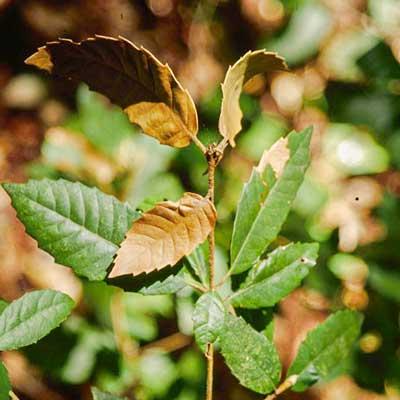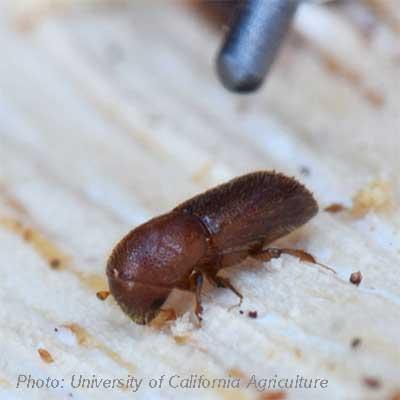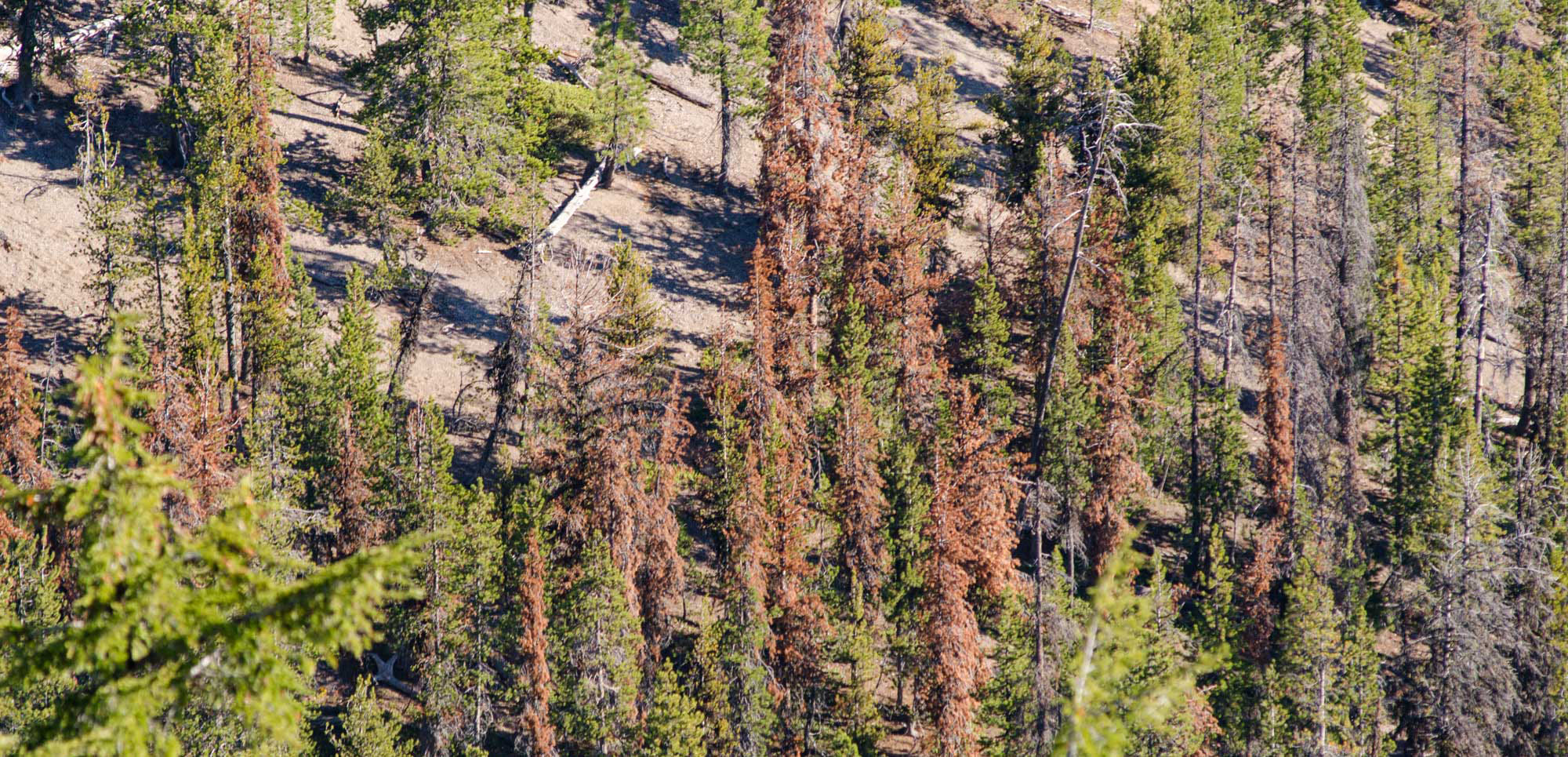A healthy forest depends on its ability to withstand challenges, which typically fall into two categories: abiotic and biotic. Abiotic issues are non-living factors such as drought, extreme weather or poor soil conditions, which can stress trees and disrupt forest growth. Biotic issues involve living factors such as pests, diseases or invasive plants, which can weaken trees and compete for resources.
These challenges don’t exist in isolation. In fact, the combination of abiotic and biotic stressors can create a compounding effect, making problems worse. For example, drought (an abiotic issue) can weaken trees, leaving them more vulnerable to pests or diseases (biotic issues). Addressing both types of challenges through good forest management is essential to maintaining a healthy, thriving forest.
Managing and promoting good forest health
Effective forest management can help lessen the impact of abiotic and biotic stressors, making your forest more resilient.
Manage stand density and reduce competition
Active management, including thinning overcrowded stands, helps trees access the sunlight, water and nutrients they need to grow. Reducing competition among trees not only improves growth rates but also makes individual trees more resilient to abiotic stressors such as drought.
Eliminating invasive plants and weeds further reduces competition, ensuring that native trees and plants have the resources to thrive.
Monitor and manage pests and diseases
Regularly inspect your forest for signs of pests or disease. Early detection is critical, as it allows you to take recommended actions to control the spread — such as removing infected trees or applying targeted treatments. Consulting a stewardship forester or extension agent can help you identify problems and choose the best course of action.
Oregon Forest Pest Detectors
This program trains participants to identify and report signs of invasive pests such as the emerald ash borer or Asian long-horned beetle. By participating in this program, you can play an active role in protecting Oregon’s forests from harmful pests and contribute valuable data to help track and manage infestations.
Why are my trees dying?
Do you own forestland in western Oregon? Not sure why some of your trees are struggling or dying? Identifying the cause can feel overwhelming, especially with so many potential abiotic and biotic stressors at play. Common culprits include drought stress, invasive pests, fungal diseases and overcrowded stands.
To help western Oregon landowners better understand these issues, experts from the Oregon Department of Forestry, Oregon State University Extension Service and U.S. Forest Service offered a four-part online course focused on tree health in the Willamette Valley. Here are recordings from each of the webinar sessions:
Tree Health Webinar Series: Western Redcedar
Christine Buhl discusses the forest health outlook for western redcedar, future projections in Oregon, and actions that landowners and managers can take for their trees.Tree Health Webinar Series: True Firs
Laura Lowrey discusses the forest health outlook for true fir trees, future projections in Oregon, and actions that landowners and managers can take for their trees.Tree Health Webinar Series: Douglas-Fir
Dave Shaw discusses the forest health outlook for Douglas-fir, future projections in Oregon, and actions that landowners and managers can take for their trees.Tree Health Webinar Series: Alder and Broadleaf Trees
Glenn Ahrens discusses the forest health outlook for alder and broadleaf trees, future projections in Oregon, and actions that landowners and managers can take for their trees.
Insects and diseases
Invasive pests and diseases pose a serious threat to forest health because they often lack natural predators or controls, allowing their impact to spread rapidly and cause significant damage to trees and ecosystems. Early detection and proactive management are essential to prevent widespread harm from invasive pests and diseases.
The Forest Insect & Disease Leaflet (FIDL) series [link to https://www.fs.usda.gov/science-technology/forest-health-protection/publications-reports/forest-insect-disease-leaflets], developed by the U.S. Forest Service, is an invaluable resource for forest landowners. These publications provide concise, high-quality guidance on identifying, managing and preventing pests and diseases that threaten forest health.
The FIDL series is organized into four main categories to help landowners easily find the information they need:
- Insects: Includes resources on bark beetles, defoliators, sucking insects and pests affecting shoots, twigs, seeds and seedlings.
- Pathogens: Focuses on cankers, root and foliage diseases, mistletoes, and wood rots.
- Many: Addresses issues caused by multiple agents, such as oak decline or beech bark disease (found primarily in the eastern U.S.).
- Unknown: Covers forest health issues with unknown causes.
The insects and pathogens categories are further divided into subtopics, making it easier to pinpoint relevant guidance.
Some of the most concerning invasive threats to Oregon’s forests include:

Emerald ash borer: This invasive beetle attacks ash trees, causing widespread mortality. Learn more about the emerald ash borer here.

Sudden oak death: Caused by the pathogen Phytophthora ramorum, this disease primarily affects tanoak but can also cause dieback in other host species, including Douglas-fir. It poses a significant threat to forest health in Oregon. Learn more about sudden oak death here.

Mediterranean oak borer: This invasive beetle poses a significant threat to oak trees in Oregon, causing damage by boring into the wood and introducing harmful fungal pathogens. Learn more about Mediterranean oak borer here.
Get more information about invasives by reading this Oregon Department of Forestry fact sheet or by visiting the Oregon Invasive Species Council website.
Identifying insects and arthropods in Oregon
If you find an insect or arthropod on your property and want to confirm its identity, there are resources available to help. Proper identification is crucial for determining whether the insect poses a threat to your forest, as some may be invasive pests, while others could be harmless or even beneficial.
The Oregon State University Extension Service offers insect and arthropod identification services and provides guidance on how to properly collect and send samples for analysis.
ADDITIONAL RESOURCES
Oregon Department of Forestry forest health webpage
Oregon Department of Agriculture webpage to monitor state quarantine areas and view forest pest alerts
Oregon Forest Health Highlights reports to review the status and trends of forest health conditions within Oregon
State of the State: Forest Health conference or online webinar to stay updated on current forest health issues impacting Oregon
PUBLICATIONS
Managing Insects and Diseases in Oregon Conifers
This publication discusses options for managing major pests and diseases affecting conifers in Oregon’s forests.
Oregon Forest Pest Detector Field Guide
This publication was developed for Oregon Forest Pest Detectors as a field reference guide.
VIDEOS
Insects in the Trees: Pest or Non-Pest?
Discover how to identify insects in trees and determine whether they are pests or beneficial to the ecosystem.
Managing Root and Butt Rot of Conifers
Learn about managing the four major root and butt diseases of conifers in western Oregon caused by fungi that decay live roots and penetrate the heartwood.
Wind, Rain and Dead Tanoak: Sudden Oak Death in Oregon
Explore the impacts of sudden oak death in Oregon, including how the disease spreads.
Managing to Keep Your Forest Healthy
Learn diagnostic methods and tools to assess and manage forest and tree health, considering factors such as climate, soils, exposure, aging, and interactions with insects or diseases, while understanding potential impacts of climate change.
Spacing and Thinning of Young Stands
Learn how to manage conifer stands less than 15 years old, focusing on thinning to prevent overcrowding and promote healthy growth.
OTHER
Pacific Northwest Pest Management Handbooks
The Pacific Northwest Pest Management Handbooks provide up-to-date, science-based guidance on managing pests, diseases and weeds specific to the region.
Invasive and Exotic Species of North America
This information-packed website is hosted by the Center for Invasive Species and Ecosystem Health at the University of Georgia.
U.S. Forest Service — Western Root Disease
Learn about root disease and find fact sheets for issues such as root rot and sudden oak death on this webpage.
U.S. Forest Service — Invasive Species
Learn more about invasive species and the challenges they create on this webpage.
Forest Pests of North America
The purpose of this website is to provide images and information about insects, diseases, weeds and abiotic factors that cause damage to urban, managed and natural forests.

